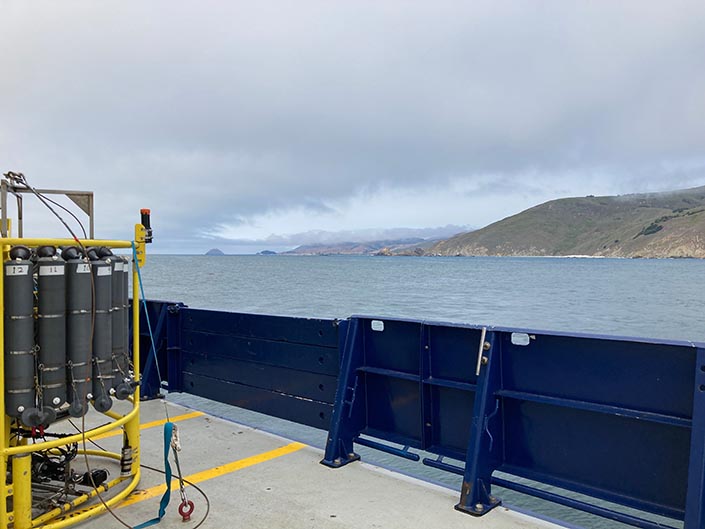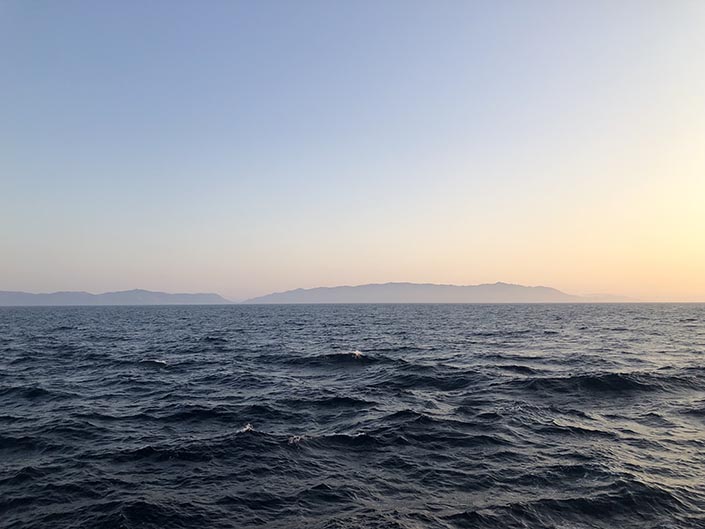Study Illuminates Previously Unknown Ocean Mercury Pathway
Team describes source of the heavy metal that poses a danger to human health
Published Date
Story by:
Media contact:
Topics covered:
Share This:
Article Content
In early May, the neurotoxic effects of the heavy metal mercury made news when outlets reported that 2024 U.S. presidential candidate Robert F. Kennedy Jr. said in 2012 that he experienced cognitive issues such as memory loss due to mercury poisoning, likely from a diet heavy in tuna.
Now, a new study from researchers at UC San Diego’s Scripps Institution of Oceanography finds that a poorly understood, highly toxic form of mercury, called dimethylmercury, may be a significant source of monomethylmercury off the California coast. Monomethylmercury is the form known to accumulate in seafood and sicken people.
The findings, published June 7 in Environmental Science and Technology, are an essential step toward mapping the sources of monomethylmercury in the oceans. Understanding the sources of the compound is also key to predicting how quickly concentrations of the toxin might decline in marine food webs if human activities that release mercury, such as burning coal and artisanal gold mining, are curtailed.
“Our predictions for the future are only as good as our understanding of the system, and we still have a lot to learn,” said Hannah Adams, a Scripps PhD candidate studying chemical oceanography and lead author of the study.
The National Science Foundation-supported research was undertaken as part of Scripps’ newly reestablished Center for Oceans and Human Health, which has understanding how contaminants like methylmercury bioaccumulate in marine food webs as one of its three main goals.
Not only is monomethylmercury a potent neurotoxin, but it is very difficult for most organisms to get rid of once it enters their system. This means organisms accumulate mercury over the course of their lives and pass it on to any predator that consumes them. Through a process known as biomagnification, marine predators such as tuna, swordfish, sharks and dolphins can contain monomethylmercury levels up to 10 million times what is found in seawater. If humans eat too many large predatory ocean fish, they can begin to experience neurological symptoms including tremors, memory loss and a lack of coordination. Such neurotoxic effects are also why people who are pregnant or breastfeeding are advised to avoid eating certain ocean fish during pregnancy, as mercury can damage the baby's developing brain and nervous system.
The majority of the mercury that enters the oceans comes from humans. Industrial activities including coal burning, cement production, production of metals such as aluminum and copper, as well as artisanal gold mining release vaporized mercury into the atmosphere. Once in the atmosphere, mercury circulates until it is deposited back on Earth’s surface, often along with rain. The mercury that falls into the ocean is in an inorganic form that is not readily absorbed by living things. But bacteria can transform some of this inorganic mercury into the dangerous organic form of monomethylmercury, which can then enter the marine food web.
It’s unclear exactly how, but chemical or biological processes also turn some of the monomethylmercury in the ocean into another of mercury’s organic forms: dimethylmercury. This compound is also a neurotoxin — just a few drops through a latex glove killed chemist Karen Wetterhahn in 1997 — but it’s not known if it bioaccumulates the way monomethylmercury does. Previously, most researchers assumed dimethylmercury was a minor player in marine mercury cycling, but this was largely because it had not received much research attention. There have been fewer than 1,000 reported measurements of marine dimethylmercury globally, but one study estimated that some 30-80% of the organic mercury in the oceans exists in the form of dimethylmercury.
A portion of the various types of mercury in the ocean ends up sinking to the seafloor, which, in aggregate, means mercury concentrations are generally higher in deeper waters. Prior research conducted off the coast of California has shown that the region’s prolific coastal upwelling, which brings nutrient-rich deep water to the surface and fuels marine productivity, also carries various types of mercury, including dimethylmercury, to the ocean surface.
Adams and Scripps associate professor and marine biogeochemist Amina Schartup sought to understand how mercury cycles through the oceans and what controls the chemical transformations that enable its accumulation in food webs. To do this, they decided to follow a parcel of upwelled, mercury-laden water once it reached the sea surface to see how the concentrations of different types of mercury changed over time.
In the summer of 2021, Adams and other scientists went to sea on a research vessel as part of the California Current Ecosystem Long-Term Ecological Research project. The team followed two parcels of upwelled water from the coast off California’s Monterey Bay out to sea for 11 days each, taking water samples as they went. Adams, Schartup, and their collaborators then analyzed those water samples for concentrations of mercury’s various chemical forms.

The researchers confirmed that coastal upwelling off the California coast is associated with elevated mercury levels, including significant quantities of dimethylmercury. Specifically, they found that the recently upwelled waters contained 59% more total mercury (all types combined) and 69% more dimethylmercury than water that had spent more time at the surface. But the team also found that dimethylmercury declined as the upwelled water parcels drifted at the surface, while monomethylmercury concentrations remained relatively constant.
“This was surprising because we would expect both types of mercury to decline at similar rates,” said Adams. “We hypothesized that maybe dimethylmercury is keeping monomethylmercury concentrations stable, because dimethylmercury can transform into monomethylmercury through degradation.”
Some of this degradation is caused by sunlight, but Adams said this process likely only accounts for a fraction of the degradation they observed, leaving the other mechanisms in play unexplained.
To explore their hypothesis, the researchers created a computer model informed by their newly collected data to simulate the transformations between different types of mercury and how those concentrations changed over time. The simulations from the model suggested that the degradation of dimethylmercury supplied 61% of the monomethylmercury in the surface waters.
“Researchers tend to think that the mercury that gets into fish only comes from the transformation of inorganic mercury by bacteria, but we show that dimethylmercury is likely a significant source off the coast of California,” said Schartup. “Dimethylmercury is important and needs to be better understood.”
Such an improved understanding could help predict how mercury levels in sea life might respond to reduced emissions of the heavy metal or to climate change, which could supercharge upwelling and send even more mercury into surface waters.
“We may need to understand the relationship between these two types of organic mercury to get a realistic expectation of the time lag between something like lowering mercury emissions and seeing a reduction in mercury levels in seafood,” said Schartup.
Schartup said answering these questions feeds directly into one of her major goals for her project at the Scripps Center for Oceans and Human Health: Creating an improved global model of mercury cycling that can be used to study the impacts of different climate change scenarios on the neurotoxin. Part of the project will also involve further exploring the link between upwelling, biological productivity, and mercury levels in marine life.
In addition to Adams and Schartup, Carl Lamborg and Xinyun Cui of UC Santa Cruz co-authored the study.
Learn more about research and education at UC San Diego in: Climate Change

You May Also Like
UC San Diego is Strengthening U.S. Semiconductor Innovation and Workforce Development
Technology & EngineeringStay in the Know
Keep up with all the latest from UC San Diego. Subscribe to the newsletter today.




